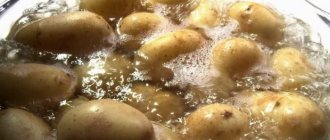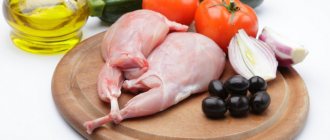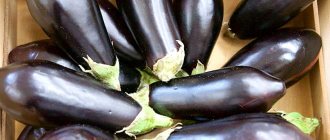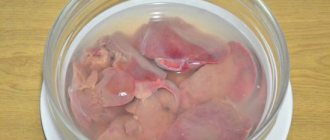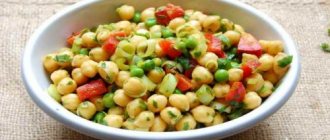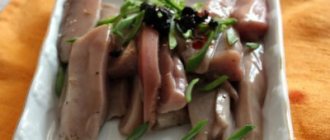Health
Lifehacks
Products
Adviсe
Life without potatoes is not life. Imagine how many amazing dishes we would lose if potatoes were removed from cooking! Unfortunately, fewer and fewer people grow their own crops and more and more people buy this delicious product in stores. However, the quality of such potatoes leaves much to be desired...
Experts recommend that all purchased potatoes be soaked in water before cooking. These recommendations especially apply to people with allergies, diabetics and young children. Why do you need to soak potatoes , what is the reason for this and how to do it correctly, find out from this article.
Action of carbohydrates
But sometimes disputes over the use of potatoes by diabetics still arise due to the special effect of carbohydrates on the patient’s body. Carbohydrates are divided into simple and complex:
- Simple. The human body absorbs this substance quite easily. After entering the blood, it begins to change the amount of sugar in it, increasing it.
- Complex (polysaccharides). They are absorbed much more slowly, and some of their components may not be accepted by the body. This element is found in corn, cereals, and potatoes. With abundant consumption of junk food, fat reserves increase in the human body, which is undesirable not only for diabetics, but also for people who do not have such a disease.
The human body, both healthy and sick, needs the right amount of carbohydrates in its daily menu. This useful component is found in fruits, legumes, vegetables, and also in cereals. But people diagnosed with diabetes should be extremely careful when consuming various foods, such as potatoes.
How is potato starch harmful for diabetes?
The high starch content in potatoes contributes to the development of pathological processes in the body. For this reason, this product should be consumed after soaking. This measure helps reduce the starch content, the product will move from the harmful category to the healthy group.
Why starch is dangerous
This substance is not harmful when used correctly. It is distinguished by its ability to bind components, thereby providing the effect of thickening liquids. For example, starch is used for this purpose in soups.
However, when it enters the gastrointestinal tract, this substance is destroyed and converted into sugar.
At the same time, the intensity of the negative effect on blood vessels increases, which can lead to the development of atherosclerosis, heart attack, stroke, and hypertension.
Against the background of these factors, the risk of developing type 2 diabetes mellitus increases, which is the result of a redistribution of sugar, which is actively synthesized from potatoes and starch. Its content is 20%.
There are varieties with lower starch content, but the difference between the actual and normal value is small.
This means that sugar is formed in the body of any person, but not everyone has diabetes.
All these diseases are interconnected, because they develop as a result of 2 processes: an increase in sugar content, a change in the properties of the walls of blood vessels. The last factor influences any processes in the body.
This is due to the fact that when the vessels are damaged, their lumens are clogged, which affects the intensity of blood circulation. Metabolic processes are disrupted, which can contribute to a lack of nutrients in tissues.
Against the background of loss of vascular properties, a sufficient level of protection is not provided, the immune system is weakened, and becomes susceptible to the development of various diseases. Impaired functioning of the cardiovascular system and diabetes are not all the consequences. For example, frequent consumption of uncooked potatoes leads to weight gain.
Another danger of consuming starch is the high risk of developing allergies. This component contributes to the appearance of a negative reaction in adults and children. But the latter more often react to this component in potatoes or other products. To eliminate the risk of developing allergies or other complications, consider soaking the starch.
To eat potatoes or not to eat
When such a product is consumed, pathological processes do not develop in a healthy body, as occurs against the background of reduced immunity, impaired metabolism and a decrease in the lumen of blood vessels. However, in this case, there remains a risk of weight gain due to the growth of the fat layer. For this reason, you should learn how to remove starch from potatoes.
At home, soaking is the simplest and most accessible method to make potatoes less harmful. It is believed that when this substance is removed, nothing useful will remain in the tuber pulp.
However, this is a misconception: potatoes contain micro- and macroelements, for example, silicon, boron, rubidium, vanadium, vitamins C, group B, K.
This means that the composition of the product changes insignificantly, the bulk of the beneficial substances are retained after processing.
This means that it is possible and even necessary to eat tubers, but first you need to understand how to soak potatoes. There are different ways to remove starch: the potatoes remain whole or they are crushed. In both cases, harmful components are effectively removed.
Moreover, not only starch is removed, but also toxic compounds that penetrate into the tubers from the soil.
Considering that the beneficial substances are not destroyed during soaking, but it is possible to make the product cleaner, it is recommended to leave it in water every time before cooking.
How to prepare a root vegetable
The instructions for soaking tubers before heat treatment are the same. The difference lies in the way the potatoes are chopped. Take a container and fill it halfway with water. Tubers are placed in it, they need to be cut into pieces or slices. For example, patients suffering from diabetes mellitus chop the potatoes even further - using a grater.
Particular attention is paid to small fruits, since they often contain a larger dose of toxins and absorb them faster. In addition, when inspecting potatoes, you need to pay attention to the quality of the tubers.
They should not have rusty, gray or dark spots. When the tubers are sorted, they are peeled.
Considering that the outer shell contains the largest amount of toxic substances, it is recommended to remove the skin as thick as possible.
Potatoes are left whole or cut into pieces. When necessary, it is ground on a grater. Then the prepared tubers should be left in water for several hours. If I have free time, I soak the tubers for 1 day. However, you must follow the rules:
- 1-2 hours after the prepared product has been soaked, the liquid is drained and clean water is poured in instead;
- wait another 1-2 hours, repeat the steps;
- The third time the liquid is drained, but water is poured into the container with the potatoes with the addition of a small amount of salt and ascorbic acid.
This method allows you to completely remove harmful substances from the tubers, including starch. Before use, potatoes must be separated from the slightly acidic solution. During the preparation of the product, a potato press is used.
Options for dishes with potatoes
When choosing a soaking method, you need to take into account the type of dish you plan to cook. For example, if you plan to make puree, you can chop the tubers as much as possible (on a coarse grater).
Thanks to this, the product will cook as quickly as possible. If foam forms during cooking, remove it. To prepare boiled potatoes with butter and herbs, simply divide the tubers into several parts.
The roast is also prepared using coarsely cut potatoes. Other dishes:
- potato babka with bacon, onions, tomatoes and mushroom sauce;
- baked potatoes with cheese;
- casserole with vegetables, cheese;
- potato and fish casserole (with salmon);
- Greek-style potatoes with the addition of different types of pepper, feta cheese and spices;
- Bulgarian potatoes with cottage cheese, yogurt and cheese;
- baked potatoes with mushroom sauce;
- potatoes wrapped in bacon with salmon, cheese and spices.
Each of these recipes uses tubers cut into several pieces. Grated potatoes can be used to make casseroles.
Potato alternative
To choose a product to replace tubers, you need to decide for what purpose it will be used. If the ability of potatoes to glue substances is important, you can pay attention to flour, and flaxseed flour works better than others. In addition, starch can be replaced with pumpkin seed flour, as well as shredded coconut.
Potatoes are not very rich in nutrients, so it will be difficult to find a complete replacement. The closest properties to this product are turnip and Jerusalem artichoke. However, the latter also contains starch, albeit in smaller quantities. For this reason, Jerusalem artichoke is also used for diabetes.
Before potatoes were often used, turnips were used to prepare various dishes. It was boiled and consumed in its pure form with additives or as part of dishes. Other replacement options:
- swede;
- turnip;
- parsnip.
These are root vegetables of different types, but in terms of the range of useful substances and properties they are superior to potatoes. In addition, it is recommended to plant new vegetables every 3-5 years in order to maintain crop rotation. If the task is to replace one product with another, more useful one, then you can choose any of the listed options.
Source: https://okartofane.ru/lechenie-kartofelem/kak-vredit-kartofelnyj-krahmal-pri-saharnom-diabete
Video of the day
Step 1
Choose potatoes with lower starch levels. There are many different types of potatoes on the market, and some have a higher starch content than others. Look for potatoes that are high in water content and low in starch, including red and white potatoes. These types are usually boiled or fried. Potatoes with a high starch content and low water content include mashed potatoes, which are popular for mashing and baking. Yukon Gold potatoes are also high in starch and low in water.
Step 2
Soak raw potatoes in a container for up to four hours. Potatoes must be completely submerged to prevent oxidation and discoloration. After four hours, the potatoes should be washed with cold water. Shredding, cutting or otherwise slicing potatoes will produce more starch.
What can you do with sweet potatoes?
If the potatoes have become sweet, you can eliminate the unusual taste by using spices, combining them with sour or pickled vegetables, or adding a spoonful of vinegar to 1 liter of water when cooking.
Interesting materials:
How to water an indoor rose? Rose cuttings have produced leaves, what should I do next? What to do to make roses last a long time? What to do to get a rose to take root? What to do to prevent roses from wilting? What to do to make roses bloom magnificently? What to do to make a Chinese rose bloom? What to do if your indoor rose dries out? What to do if a rose grows into a rose hip? What to do if the rose has gone wild?
Factors provoking the development of pathology
Allergy to potatoes develops quite rarely. Experts believe that it contains irritants in small quantities. As a result, the vegetable is included in the diet prescribed for allergy sufferers.
Despite this, sometimes the human body reacts in a specific way to certain components of potatoes. Vegetable components such as starch and protein formations - penton and tuberine - can act as irritants.
The formation of the disease is often associated with a genetic predisposition. In adults, hypersensitivity to eating potatoes develops in rare cases.
Often, an allergy to potatoes develops in an infant or a child of a younger age category. But in almost 90% of cases, this problem completely ceases to bother us at about 6 years of age, and proper treatment in such a situation is important.
There is an opinion that under the influence of high temperatures, irritants in the root crop do not decrease. But allergic symptoms most often appear when peeling and cutting root vegetables before cooking. This is initially due to an increased concentration of allergenic substances in the juice that is released when peeling potatoes.
With constant peeling of the vegetable in a significant amount, a person predisposed to intolerance may develop an allergic rash on the hands and contact dermatitis.
Often, during a consultation with a specialist, people complain about the formation of allergies during contact with young potatoes. This phenomenon is observed when cleansing the root vegetable - some patients note that it is itchy, sore throat and a cough appears, others complain of the appearance of contact dermatitis.
Respiratory symptoms and rashes on the hands when peeling young potatoes develop due to the increased content of starch and iodine in the peel of the root vegetable. It is thanks to iodine that irritation appears on the skin and mucous membranes of the larynx, and under the influence of starch this phenomenon intensifies.
Let's understand the issue. Does it make sense to soak potatoes to remove nitrates?
Footage.framepool.com
Soaking vegetables is a simple and effective way to reduce nitrates. Up to 25 percent of these substances are concentrated on the surface of the peel.
Being water soluble, they dissolve into room temperature water within an hour, making the product safer. An even safer option is to cut off the peel to remove up to 80 percent of the hazardous substances if you plan to eat the vegetable fresh.
Or subject it to heat treatment: boil, stew, fry. In this case, there are no nitrates left in the vegetables at all.
Potatoes, unlike other vegetables, are not eaten fresh. Therefore, there is no point in soaking it to “remove harmful substances.” When boiling, baking and frying, nitrates are quickly destroyed; from this point of view, the root vegetable is absolutely safe. It is considered dubious for another reason - due to its high starch content.
When potatoes are boiled, nitrates are destroyed (Footage.framepool.com)
Risk of high blood glucose
Starches are a group of substances that, when digested in the body, turn into glucose. Potatoes of any type contain a lot of starch, which is why they are considered controversial products.
On the one hand, frequent consumption of potatoes increases the risk of diabetes, hypertension and obesity (this is confirmed by scientific research). On the other hand, potatoes are a valuable source of potassium, the content of which surpasses other vegetables and even fruits.
It also contains polyphenols - biologically active substances that can resist cancer and reduce the harmful effects of free radicals.
And finally, potatoes are a tasty and affordable product.
When other vegetables are significantly more expensive, people are more willing to buy potatoes, which they use to prepare hearty everyday meals.
Potatoes contain starch, potassium, polyphenols (Pixabay.com)
Soaking the potatoes before cooking allows you to find a balance between the harm of starch and the benefits of the biologically active substances of the root vegetable.
Potato soaking technique
During soaking, the starchy masses are partially washed out of the tubers. They come out of the root pulp and concentrate on the surface. The longer the tubers are in water, the more starch they lose. To get rid of starchy compounds, proceed as follows.
- Wash the potatoes, peel them or leave them in them.
- Cut the tubers into four parts.
- Fill with cold running water until it just covers the pieces.
- Leave for an hour, drain the water.
- Fill with water for another hour, drain, and rinse the potatoes.
When soaked, potatoes lose most of their starches (Kakxranit.ru) There are especially many starchy substances in last year’s potatoes: during storage, the composition of the pulp changes. The root vegetable produces starches to provide nutrition to the sprouts. There is practically no starch in new potatoes, so there is no need to soak them.
Starch is not as harmful as it seems
Recently, nutritionists have recommended reconsidering our attitude towards starchy foods. Indeed, when they are consumed, blood sugar levels increase. But they satiate well and create a long-lasting feeling of satiety, which is useful for weight control and dieting, as it protects against sudden attacks of hunger.
In addition, the starches in vegetables and grains are different. Simple ones, which are found, for example, in boiled corn and mashed potatoes, are quickly broken down by the body into glucose.
But there are complex ones, the so-called resistant ones, they are found in cereal products and whole wheat pasta. With resistant starch, the body has to “tinker” and spend more energy on digestion.
Its breakdown takes a long time - over three to four hours, due to which the glucose level rises slowly and decreases just as slowly.
Mashed potatoes contain the most simple starch (Pixabay.com) Resistant starch is good for the body. Products containing it do not cause a sharp increase in sugar levels and create a long-lasting feeling of satiety.
Potatoes can be a source of resistant starch even without soaking. To do this, you need to prepare it and put it in the refrigerator for 24 hours.
In the cold, the structure of starchy compounds changes; the volume of substances resistant to breakdown increases fourfold.
So the healthiest potatoes are yesterday's potatoes, boiled or baked. When fried, starch is also converted into resistant starch, but the high fat content negates the benefits of the product.
- 5 myths about instant coffee. Is it harmful?
- Why are baked apples healthier than fresh ones?
- 5 valuable properties of chicken liver
Don't forget to like, subscribe to the channel and share the publication on social networks ❤ We will be pleased!
Source: https://zen.yandex.ru/media/id/5b8d2aab15125f00ae67a7f4/5d17d8d9df71c300adae84ed
Cooking recommendations
If eating potatoes is not associated with the occurrence of negative reactions, you can eat them every day, but not more than 200 g. People with high blood sugar, gout and young children should limit their consumption to 100 g per week. Regardless of the cooking method, it is better to soak the potatoes.
To maintain the usefulness of the product and achieve the best taste, you can use the following tips:
- To prevent the skin of the tuber in its uniform from bursting, add a couple of drops of vinegar to the water.
- To speed up cooking, add a piece of butter (margarine) to the pan.
- To make the tubers lighter, you need to add 1 tsp during cooking. lemon juice.
- Purees should be eaten fresh. During heat treatment, it loses 30% of vitamin C, and when heated again, there will be no vitamins left in it.
- To obtain tasty and crumbly boiled potatoes, you need to pour salted boiling water over the soaked tubers.
- To minimize the amount of nitrates in store-bought potatoes, it is necessary to remove the skin in a thick layer. For an environmentally friendly product, another rule is to peel it as thinly as possible, and better yet, eat it with the peel, since it contains more vitamins than a peeled tuber.
- Frozen potatoes will lose their unpleasant taste if they are consumed no earlier than a week after storage at room temperature.
- Soaked potatoes are good to eat raw. It is recommended for cancer patients, people with increased swelling, metabolic disorders, and gum disease. Grated tubers can be mixed with apples and seasoned with lemon juice and honey. An important condition is the absence of pesticides.
We recommend: Can the broth be diluted with water - why are chefs against it?
Potatoes allow you to diversify your menu and saturate your body with useful microelements. If according to indications the tubers are prohibited from being eaten, soaking will correct the situation. Without starch and pesticides, potatoes are good for everyone.
Why are potatoes soaked?
Nutritionists advise everyone, without exception, to soak potatoes before cooking, but there are people who are strictly forbidden to eat tubers without prior processing.
Soaking potatoes allows you to:
- Reduce the glycemic index (GI). This is important for diabetics. Products whose GI does not exceed 50 are allowed for consumption. In potatoes, the index reaches 70–80 (in sugar - 75), which makes the product completely unsuitable for citizens with a diagnosed disease. One could avoid potatoes altogether, but they contain many substances that support the patient’s body. The only way to introduce tuber dishes into the diet is to eliminate starch. After soaking, the GI drops by 25–30 units.
- Reduce the allergenicity of the product. Cases of negative reactions are rare, but if they are present, there is a high risk of allergies to other nightshades: eggplants, peppers, tomatoes. In adults, allergies have many manifestations: rash, symptoms of respiratory disease, swelling. Infants suffer from rashes and colic. Once a reaction is detected, consumption of potatoes should be stopped, and after 3-4 months, resumed, using only environmentally friendly soaked product. A nursing mother should also stop eating potatoes if her child shows signs of an allergy.
- Reduce calories. 100 g of starch contains approximately 357 calories. Potatoes are 83% pure fast carbohydrates that promote weight gain, and removing starch reduces calories.
- Remove nitrates. It has been proven that soaking allows you to get rid of growth stimulants that have a detrimental effect on humans.
In multi-colored varietal potatoes (pink, purple), the level of sugars and starch is 30% lower than in light varieties, so their use is preferable.
How to soak potatoes before cooking?
For consumption, you need to select whole tubers without dents or signs of spoilage. You should pay attention to the color of the peel. If it is greenish, it means that the tuber has a high concentration of a toxic substance - solanine. Even in small quantities, it causes inflammation of the gastric mucosa, destroys red blood cells, and destabilizes the functioning of the nervous system.
We recommend: An exception to the rule – 5 foods that should not be washed before cooking
After selecting high-quality tubers, you need to:
- Wash and peel the tubers, cut into several pieces. If the method of growing potatoes is known and the use of nitrates is excluded, you can cook potatoes in their jackets. It must be thoroughly washed and cut into 2-4 parts depending on the size of the potato.
- Pour in water until the liquid completely covers the contents of the container with tubers. Leave to wash out the starch for 60 minutes.
- Drain the water and repeat the process: pour in, leave for an hour. Afterwards, drain.
- Fill the tubers with clean water. Starch removal time is 12 hours. Afterwards, drain the water and prepare the dish.
The smaller the potatoes are cut before soaking, the easier the starch will come out of them. The processing time can be reduced by 4 times if you grate the tubers on a coarse grater before the procedure.
